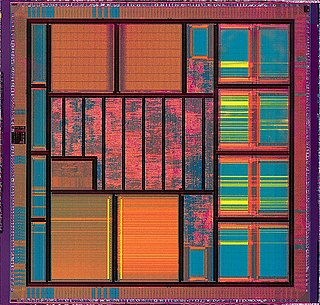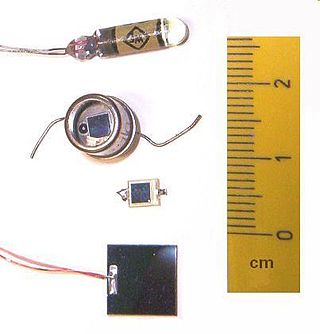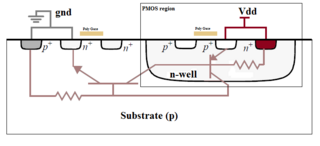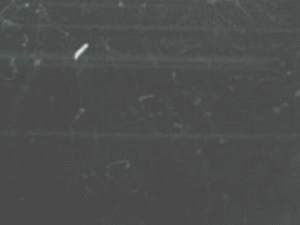
Very-large-scale integration (VLSI) is the process of creating an integrated circuit (IC) by combining millions or billions of MOS transistors onto a single chip. VLSI began in the 1970s when MOS integrated circuit chips were developed and then widely adopted, enabling complex semiconductor and telecommunication technologies. The microprocessor and memory chips are VLSI devices.

A photodiode is a semiconductor diode sensitive to photon radiation, such as visible light, infrared or ultraviolet radiation, X-rays and gamma rays. It produces an electrical current when it absorbs photons. This can be used for detection and measurement applications, or for the generation of electrical power in solar cells. Photodiodes are used in a wide range of applications throughout the electromagnetic spectrum from visible light photocells to gamma ray spectrometers.

Static random-access memory is a type of random-access memory (RAM) that uses latching circuitry (flip-flop) to store each bit. SRAM is volatile memory; data is lost when power is removed.

Dynamic random-access memory is a type of random-access semiconductor memory that stores each bit of data in a memory cell, usually consisting of a tiny capacitor and a transistor, both typically based on metal–oxide–semiconductor (MOS) technology. While most DRAM memory cell designs use a capacitor and transistor, some only use two transistors. In the designs where a capacitor is used, the capacitor can either be charged or discharged; these two states are taken to represent the two values of a bit, conventionally called 0 and 1. The electric charge on the capacitors gradually leaks away; without intervention the data on the capacitor would soon be lost. To prevent this, DRAM requires an external memory refresh circuit which periodically rewrites the data in the capacitors, restoring them to their original charge. This refresh process is the defining characteristic of dynamic random-access memory, in contrast to static random-access memory (SRAM) which does not require data to be refreshed. Unlike flash memory, DRAM is volatile memory, since it loses its data quickly when power is removed. However, DRAM does exhibit limited data remanence.
Ionizing radiation (US) (or ionising radiation [UK]), including nuclear radiation, consists of subatomic particles or electromagnetic waves that have sufficient energy to ionize atoms or molecules by detaching electrons from them. Some particles can travel up to 99% of the speed of light, and the electromagnetic waves are on the high-energy portion of the electromagnetic spectrum.

Neutron radiation is a form of ionizing radiation that presents as free neutrons. Typical phenomena are nuclear fission or nuclear fusion causing the release of free neutrons, which then react with nuclei of other atoms to form new nuclides—which, in turn, may trigger further neutron radiation. Free neutrons are unstable, decaying into a proton, an electron, plus an electron antineutrino. Free neutrons have a mean lifetime of 887 seconds.
Radiation hardening is the process of making electronic components and circuits resistant to damage or malfunction caused by high levels of ionizing radiation, especially for environments in outer space, around nuclear reactors and particle accelerators, or during nuclear accidents or nuclear warfare.
In electronics and computing, a soft error is a type of error where a signal or datum is wrong. Errors may be caused by a defect, usually understood either to be a mistake in design or construction, or a broken component. A soft error is also a signal or datum which is wrong, but is not assumed to imply such a mistake or breakage. After observing a soft error, there is no implication that the system is any less reliable than before. One cause of soft errors is single event upsets from cosmic rays.
LEON is a radiation-tolerant 32-bit central processing unit (CPU) microprocessor core that implements the SPARC V8 instruction set architecture (ISA) developed by Sun Microsystems. It was originally designed by the European Space Research and Technology Centre (ESTEC), part of the European Space Agency (ESA), without any involvement by Sun. Later versions have been designed by Gaisler Research, under a variety of owners. It is described in synthesizable VHSIC Hardware Description Language (VHDL). LEON has a dual license model: An GNU Lesser General Public License (LGPL) and GNU General Public License (GPL) free and open-source software (FOSS) license that can be used without licensing fee, or a proprietary license that can be purchased for integration in a proprietary product. The core is configurable through VHDL generics, and is used in system on a chip (SOC) designs both in research and commercial settings.
Borophosphosilicate glass, commonly known as BPSG, is a type of silicate glass that includes additives of both boron and phosphorus. Silicate glasses such as PSG and borophosphosilicate glass are commonly used in semiconductor device fabrication for intermetal layers, i.e., insulating layers deposited between succeedingly higher metal or conducting layers.

Neutron activation is the process in which neutron radiation induces radioactivity in materials, and occurs when atomic nuclei capture free neutrons, becoming heavier and entering excited states. The excited nucleus decays immediately by emitting gamma rays, or particles such as beta particles, alpha particles, fission products, and neutrons. Thus, the process of neutron capture, even after any intermediate decay, often results in the formation of an unstable activation product. Such radioactive nuclei can exhibit half-lives ranging from small fractions of a second to many years.

In electronics, a latch-up is a type of short circuit which can occur in an integrated circuit (IC). More specifically, it is the inadvertent creation of a low-impedance path between the power supply rails of a MOSFET circuit, triggering a parasitic structure which disrupts proper functioning of the part, possibly even leading to its destruction due to overcurrent. A power cycle is required to correct this situation.

Error correction code memory is a type of computer data storage that uses an error correction code (ECC) to detect and correct n-bit data corruption which occurs in memory.

In dosimetry, linear energy transfer (LET) is the amount of energy that an ionizing particle transfers to the material traversed per unit distance. It describes the action of radiation into matter.

Alpha particles, also called alpha rays or alpha radiation, consist of two protons and two neutrons bound together into a particle identical to a helium-4 nucleus. They are generally produced in the process of alpha decay but may also be produced in other ways. Alpha particles are named after the first letter in the Greek alphabet, α. The symbol for the alpha particle is α or α2+. Because they are identical to helium nuclei, they are also sometimes written as He2+
or 4
2He2+
indicating a helium ion with a +2 charge. Once the ion gains electrons from its environment, the alpha particle becomes a normal helium atom 4
2He.
A semiconductor package is a metal, plastic, glass, or ceramic casing containing one or more discrete semiconductor devices or integrated circuits. Individual components are fabricated on semiconductor wafers before being diced into die, tested, and packaged. The package provides a means for connecting it to the external environment, such as printed circuit board, via leads such as lands, balls, or pins; and protection against threats such as mechanical impact, chemical contamination, and light exposure. Additionally, it helps dissipate heat produced by the device, with or without the aid of a heat spreader. There are thousands of package types in use. Some are defined by international, national, or industry standards, while others are particular to an individual manufacturer.
Alpha strike is a term referring to the event when an alpha particle, a composite charged particle composed of two protons and two neutrons, enters a computer and modifies the data or operation of a component in the computer.

The Altitude SEE Test European Platform (ASTEP) is a permanent mountain laboratory and a dual academic research platform created by Aix-Marseille University, CNRS and STMicroelectronics in 2004. The current platform, operated by IM2NP Laboratory, is dedicated to the problematic of Single Event Effect (SEE) induced by terrestrial radiation (atmospheric neutrons, protons and muons) in electronic components, circuits and systems. Located in the French Alps on the desert Plateau de Bure at 2552m (Dévoluy mountains), the platform is hosted by the IRAM Observatory ASTEP is fully operational since March 2006.
Physical unclonable function (PUF), sometimes also called physically unclonable function, is a physical entity that is embodied in a physical structure and is easy to evaluate but hard to predict.
Row hammer is a computer security exploit that takes advantage of an unintended and undesirable side effect in dynamic random-access memory (DRAM) in which memory cells interact electrically between themselves by leaking their charges, possibly changing the contents of nearby memory rows that were not addressed in the original memory access. This circumvention of the isolation between DRAM memory cells results from the high cell density in modern DRAM, and can be triggered by specially crafted memory access patterns that rapidly activate the same memory rows numerous times.










